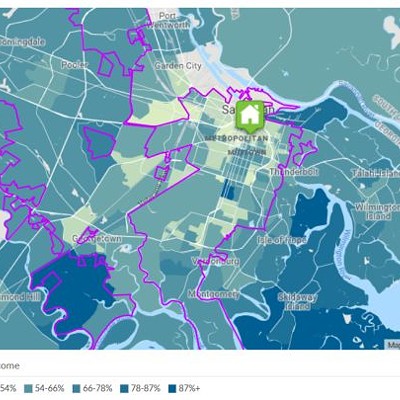THERE ARE many good reasons that one might choose to oppose a real estate development project. The simple fact that it will rise to the diabolical height of five stories, in an urban area, is not a good reason.
(Note: I sit on the board of the Thomas Square Neighborhood Association, but the opinions expressed in my column do not represent the board.)
Zoning changes that would allow the Starland Village project to proceed without major changes to its so-far proposed design will come before City Council this week. The height of five stories seems to be the issue that most opponents are hung up on.
The requested zoning changes were approved by the MPC at its last meeting. At this meeting, local architect Pat Shay spoke in favor of the project (no, he is not designing it).
After Shay was done with his remarks, a member of the MPC board asked him directly if he thought the height of the proposed new structures would be detrimental to the neighborhood.
I was there taking notes, but I asked Shay to re-state his response in an email. Here is what he wrote to me:
“People cannot perceive actual height. What people see is scale. A well-scaled building at 7 stories can look great next to a 3-story building, if they are in scale. Most people do not perceive buildings more than the lowest 30 feet — so that if this region of a building is well scaled it will be perceived favorably, and whether it is four or five stories tall will be unknown [by the person perceiving it],” he wrote.
“This effect has been proven in scientific experiments over and over again. The worst way to analyze this effect is with a flattened out elevation drawing. No one sees or experiences buildings or places in this way. Unfortunately it is the easiest way to draw and so it is the most frequently used to judge buildings.
“Average human beings perceive scale, not height, and this has guided architecture for thousands of years,” he concludes.
So, according to this point of view, height itself is not a detriment if the building is designed well. A poorly designed building of one story can just as easily detract from a neighborhood. We have plenty of such buildings in downtown Savannah.
But signs placed on streets around Starland Village by opponents state that five stories is too big and will cause no less than the “destruction of our neighborhood.”
Literally and directly, the only things being destroyed are a 3,000 square foot former medical office building dating to 1985 (one story and poorly designed), and three surface parking lots.
No residential structures are being lost. No people are being displaced. An arborist and the Savannah Tree Foundation are being consulted to do as little harm to live oaks as possible.
Instead, around 90 rental units will be constructed, along with office and commercial space, and an events venue. Existing church properties will be renovated.
Now, I will not be obtuse and insist that objections about height are just about the height. I know that often they are really about other things.
I will sum these other things up as “quaintness” because that is the code word I’ve heard from many opponents. They want to keep things quaint.
The equation goes like this:
Tall building = density/more people = more automobiles = congestion and parking problems = loss of quaintness
They propose to disrupt the equation like this:
[No] Tall Buildings
However, I propose that we disrupt the equation like this:
more people ≠ more automobiles
John Bennett started his column last week with a quote from architect Tony Garcia at the Georgia Walks Summit. It bears repeating this week and every week:
“Every city thinks it has a parking problem. Or a traffic problem. You don’t. You have a car problem.”
If there is any factor that truly has a direct and inverse correlation to quaintness, it is not building height, but the accommodation of cars.
In her recent letter to the Savannah Morning News, Virginia Mobley made this statement in regards to those in the neighborhood opposed to the project:
“They are concerned about the historic attributes and quality of life that makes this a unique neighborhood. Once that quality is gone, it cannot be rebuilt.”
I respectfully disagree on two counts. First, a five-story building, on its own merits, will not destroy these things. Second, you can rebuild historic attributes and quality of life by inconveniencing cars.
For examples, just look at Ellis Square and Price Street.
Back in the day, I worked on Ellis Square at the much-missed Mercury Lounge. I often checked IDs at the front door while staring at the hideous parking garage that occupied the square for 50 years.
Now that parking garage is gone. Cars must go underground to park. The ward is much more quaint.
I used to live just off Price Street. From inside my apartment I could hear collisions on a weekly basis where it crossed 37th Street. The two lanes of one-way traffic were a dangerous speedway, but much liked by drivers leaving downtown.
Now Price is just one lane, with parking and a bike lane in place of the other. There are far less crashes, street trees and other foliage have been allowed to grow out, and I believe that almost every formerly vacant lot on its course is now occupied by new, infill housing. It is much more quaint than it used to be.
When it comes to Starland Village and potential harm to quality of life, it’s really all about the cars. I have two suggestions in that regard.
1) Don’t assume that the increase in activity will correlate to an equal increase in car traffic and parking needs.
Will Starland Village increase congestion and parking problems? Yes, at least in the short term. But we are moving towards a future that is less dependant on ubiquitous personal car ownership.
Until that time, there will be some discomfort, especially for those that live closest to the development, and most especially for those that don’t have their own off-street parking but consider on-street parking “theirs.” So be it.
2) Don’t be so insistent that Starland Village be so accommodating to increased car traffic, real or imagined.
Don’t like the idea of an automated parking garage on Whitaker Street? Fine. Don’t require the project to have one. Instead, let’s reduce traffic on Whitaker and Drayton to one lane and use the other for parking, as on Price. That will also address traffic calming needs.
I believe that we have to start allowing developments that fit in with a less car dependent future, now, even if all the pieces for it aren’t quite in place. I was going to write that the growing pains will be worth it, but that’s the wrong analogy.
Withdrawal symptoms are a more apt analogy, as some people’s hands start to tremble as we speak of weaning ourselves from our auto-dependence. But again, it will be worth it.
Finally, there is the insidious slippery slope argument (SSA). It says that if we allow this project to go forward, even if it is good in isolation, it will open the door to the entire Bull Street corridor being built up to a height of five stories.
The use of an SSA is not always fallacious, if the process towards the dreaded end-game can be demonstrated. However, in this case I would argue that it is not demonstrated, but merely asserted, and the SSA is a simple fear-mongering ploy.
What is demonstrated is that measures exist that would prevent the dreaded “five-story everywhere” end-game.
The Mid-City zoning area, where this project is proposed, is protected by a historic overlay. As has been stated before, no contributing structures are being demolished. Instead, existing structures are being enhanced. Contributing structures in the neighborhood will continue to be protected.
The changes proposed to the CIV zoning designation within the Mid-City district would only apply to other future projects where an existing civic structure is retained and utilized in the project (CIV zoning is not enough).
That a project such as this could happen again is a feature, not a bug. But it is a feature limited to a finite set of existing structures.
Saying no to Starland Village will not be a defense against future bad projects. It will only be saying no to a good project now.
And given how much time and effort this developer has devoted to neighborhood outreach, I’m afraid that the only lesson learned will be that it wasn’t worth it.
























